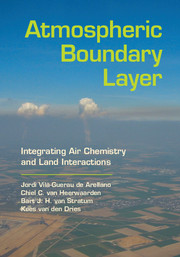Book contents
Preface
Published online by Cambridge University Press: 05 July 2015
Summary
Buffering the free atmospheric conditions from the soil-vegetation properties, the atmospheric boundary layer (ABL) is the region in which the wind, temperature, moisture, and atmospheric constituents change from the large atmospheric scales to the biosphere conditions. Over land, the ABL is characterized by a strong diurnal variability (daylight hours) that presents a challenge to modelling studies and observational interpretation. The first purpose of this book is to introduce the reader systematically to the most important biogeochemical and physical processes that take place in the ABL. A flexible user-friendly model of these processes called Chemistry Land-surface Atmosphere Soil Slab (CLASS) was developed to enable the reader interactively and independently to investigate the behaviour of the diurnal ABL over land. Our second aim is to enable the reader to discover freely the interactions and couplings that occur between the atmosphere and land, and to determine their impact on cloud formation, changes in greenhouse gas concentrations, and atmospheric chemistry. To this end, we decided to represent the main fundamental processes in the atmosphere-biosphere system, while retaining the essential components of the physical and biogeochemical processes involved. We have therefore attempted to move beyond individual disciplines to investigate their mutual interrelationships and feedback, laying special emphasis on the conceptualization of the problem. Finally, the interactivity and modular character of the book will make it very useful as a means of interpreting measurements made during experimental campaigns and deepening our understanding of more complex large-scale biogeochemical atmospheric models.
Information
- Type
- Chapter
- Information
- Atmospheric Boundary LayerIntegrating Air Chemistry and Land Interactions, pp. xiii - xivPublisher: Cambridge University PressPrint publication year: 2015
